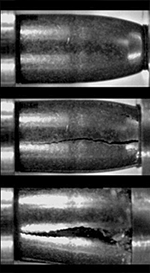Frangibility
Frangibility is a property that describes the ability of a material or object to break, shatter, or fragment under impact, pressure, or stress. This characteristic is crucial in various fields, including materials science, engineering, safety engineering, and military science, as it affects the design, application, and safety of structures, devices, and systems.
Overview[edit | edit source]
Frangibility is often considered when designing objects that need to break apart safely upon impact to minimize the risk of injury or damage. Examples include breakaway posts used in road signage, frangible bullets designed to disintegrate upon hitting a hard surface to reduce collateral damage, and certain types of glass that are designed to shatter into less harmful pieces. The concept is also applied in the design of structures that need to collapse in a controlled manner under certain conditions, such as in earthquake engineering.
Materials and Design[edit | edit source]
The frangibility of a material is determined by its physical and chemical properties, including its brittleness, ductility, tensile strength, and elasticity. Materials such as glass, certain ceramics, and some metals can exhibit high levels of frangibility under specific conditions. Engineers and designers must carefully select materials based on their frangibility to ensure the safety and effectiveness of their products and structures.
Applications[edit | edit source]
Safety Engineering[edit | edit source]
In safety engineering, frangibility is a critical consideration in the design of crash barriers, lighting poles, and other roadside infrastructure. These items are designed to break or yield upon impact from a vehicle, thereby absorbing some of the crash energy and reducing the risk to the occupants.
Military Science[edit | edit source]
The military uses frangible materials in the design of certain munitions, such as frangible bullets, which are intended to break apart upon impact to minimize over-penetration and reduce the risk of collateral damage in training environments or urban warfare.
Aerospace and Aviation[edit | edit source]
Frangibility is also an important factor in aerospace and aviation, particularly in the design of structures around airports. Objects such as approach lights and navigational aids must be frangible to minimize the damage to aircraft in the event of a collision.
Challenges and Considerations[edit | edit source]
Designing for frangibility involves balancing the need for an object to perform its intended function while ensuring it breaks safely under specific conditions. This requires a thorough understanding of the material properties and the forces that the object may encounter during its lifecycle. Additionally, there are challenges in predicting how complex structures or systems will behave when part of them fails, making it essential to conduct extensive testing and simulation.
Conclusion[edit | edit source]
Frangibility is a key property that influences the design and application of a wide range of materials and systems. By understanding and harnessing this property, engineers and designers can create safer, more efficient products and infrastructure that better protect human life and property.
Search WikiMD
Ad.Tired of being Overweight? Try W8MD's NYC physician weight loss.
Semaglutide (Ozempic / Wegovy and Tirzepatide (Mounjaro / Zepbound) available. Call 718 946 5500.
Advertise on WikiMD
|
WikiMD's Wellness Encyclopedia |
| Let Food Be Thy Medicine Medicine Thy Food - Hippocrates |
Translate this page: - East Asian
中文,
日本,
한국어,
South Asian
हिन्दी,
தமிழ்,
తెలుగు,
Urdu,
ಕನ್ನಡ,
Southeast Asian
Indonesian,
Vietnamese,
Thai,
မြန်မာဘာသာ,
বাংলা
European
español,
Deutsch,
français,
Greek,
português do Brasil,
polski,
română,
русский,
Nederlands,
norsk,
svenska,
suomi,
Italian
Middle Eastern & African
عربى,
Turkish,
Persian,
Hebrew,
Afrikaans,
isiZulu,
Kiswahili,
Other
Bulgarian,
Hungarian,
Czech,
Swedish,
മലയാളം,
मराठी,
ਪੰਜਾਬੀ,
ગુજરાતી,
Portuguese,
Ukrainian
Medical Disclaimer: WikiMD is not a substitute for professional medical advice. The information on WikiMD is provided as an information resource only, may be incorrect, outdated or misleading, and is not to be used or relied on for any diagnostic or treatment purposes. Please consult your health care provider before making any healthcare decisions or for guidance about a specific medical condition. WikiMD expressly disclaims responsibility, and shall have no liability, for any damages, loss, injury, or liability whatsoever suffered as a result of your reliance on the information contained in this site. By visiting this site you agree to the foregoing terms and conditions, which may from time to time be changed or supplemented by WikiMD. If you do not agree to the foregoing terms and conditions, you should not enter or use this site. See full disclaimer.
Credits:Most images are courtesy of Wikimedia commons, and templates, categories Wikipedia, licensed under CC BY SA or similar.
Contributors: Prab R. Tumpati, MD


